
The financial crisis is dead.
Long live the financial crisis.
First there was the share market crisis in the early 2000s that the Fed responded to with super low interest rates.
The super low interest rates played a part in fuelling a US housing bubble and encouraged the repacking of US housing mortgages into super geared securities that were sold to investors all around the world.
The unravelling of this pseudo-Ponzi scheme triggered the 2008 financial crisis.
Governments responded to the financial crisis by borrowing massive amounts of money to fund spending that offset some of the negative impact of the crisis on economic growth.
Central banks responded with super-low interest rates and quantitative easing that refuelled housing markets and debt levels.
The responses of governments and central banks to the financial crisis have laid the foundations for the next crisis/crises, just as the super-low interest rates in the early-2000s laid the foundation for the financial crisis.
China and Japan are of particular concern in this context. The aggressive Chinese response to the crisis means it is now one of the ticking time bombs we particularly focus on in our economic and forex reports, while Japan is in a class of its own when it comes to government debt levels.
This Raving puts the Japanese and Chinese threats in perspective and offers a special deal to those interested in getting access to our monthly economic and forex reports.
Only some global developments matter lots to NZ
Prior to the financial crisis there was no general link between NZ economic growth and economic growth in the G7 major Western countries (left chart).
The correlation between 1992 and 2007 was 0.05 (i.e. there wasn't a link).
The financial crisis temporarily brought a range of things into synchrony, including NZ and G7 GDP growth. But now NZ and G7 growth are back to largely doing their own things.
NZ's reliance on overseas funding is one of the key reasons why extreme global events like the financial crisis can have a major impact on NZ.
The right chart shows the % of total bank funding from non-residents. When the crisis stuck in earnest in late-2008 38% of total bank funding came from non-residents (i.e. effectively overseas).
In response the Reserve Bank (RB) has forced banks to focus more on domestic funding among other things, but banks still access just over 28% of total funding from non-residents, with this share starting to increase again following the OCR hikes delivered by the RB this year (i.e. banks are potentially responding to the increase in domestic funding costs by borrowing more from overseas where funding costs haven't increased and may have fallen this year).
This has watered down the impact of the OCR hikes, with that being an issue covered in our pay-to-view reports.
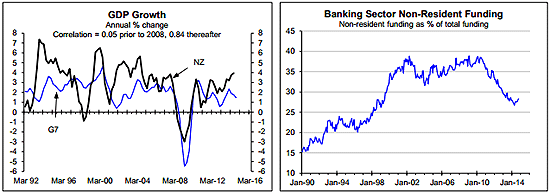
The lack of a general link between local and global economic growth is because at any one time NZ has a range of specific factors driving growth that can be quite different from the factors driving global growth (e.g. divergences in monetary and fiscal policies; divergences in population growth; special factors like Canterbury rebuilding and the government initiatives to boost residential building).
However, because banks continue to obtain a significant amount of funding from overseas NZ will remain vulnerable to global shocks that impact on the international financial sector.
Global financial risks
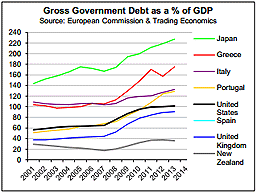 The financial crisis isn't dead because of the high government debt levels that still exist in the crisis countries (adjacent chart). NZ is included in the chart to put the debt levels in the crisis-countries in perspective.
The financial crisis isn't dead because of the high government debt levels that still exist in the crisis countries (adjacent chart). NZ is included in the chart to put the debt levels in the crisis-countries in perspective.
When it comes to debt Japan is at the top of the pile and therefore is high on the list of countries that could at some stage in the future deliver a shock to the global financial system.
It is something of a contentious issue, but as a rule of thumb if gross government debt is 100% of total economic activity or GDP a country is considered at potential risk of debt default.
This risk has been greatly reduced especially by the actions of central banks in the crisis countries (i.e. delivering super low interest rates that help keep interest costs for governments down and in some cases printing money to buy government debt).
But the high debt levels and already low interest rates greatly limit the scope for governments and central banks to respond to any future shocks.
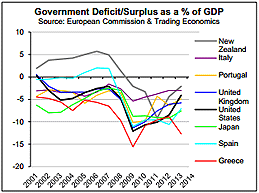 Japan is of particular importance as a potential source of a future financial shock because it has made limited progress in reducing the government operating balance or fiscal deficit (adjacent chart). Consequently, government debt as a % of GDP continues to grow.
Japan is of particular importance as a potential source of a future financial shock because it has made limited progress in reducing the government operating balance or fiscal deficit (adjacent chart). Consequently, government debt as a % of GDP continues to grow.
The challenges facing the Japanese government and central bank are made worse by a falling and ageing population that has direct relevance to funding the government debt. As covered in our monthly economic reports, Japan has embarked on a doomed experiment that has resulted in a snap election to be held on 14 December.
Whatever the result of the election it will be followed by equally doomed policy initiatives. Japan is a ticking time bomb, albeit one with a remarkably long fuse.
The outcome of the policy initiatives have major implications for the NZD/JPY, as covered in our monthly Forex Prospects reports in which we have been correctly warning about what would happen to the yen and NZD/JPY as a result of the Japanese "three arrows" experiment that is dubbed Abenomics after the Prime Minister.
The Chinese threat
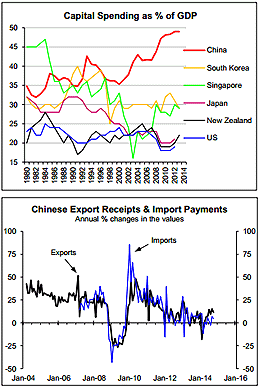 China doesn't rate as a threat in terms of central government debt, but debt default risk of shadow banks is a major issue (i.e. institutions largely acting as banks but outside the regulatory net).
China doesn't rate as a threat in terms of central government debt, but debt default risk of shadow banks is a major issue (i.e. institutions largely acting as banks but outside the regulatory net).
The adjacent chart helps put the Chinese threat that is very different from the Japanese threat in perspective. It shows capital spending as a % of total economic activity or GDP.
Capital spending includes spending on residential building, non-residential building, infrastructure, plant, machinery, equipment and inventories.
It is normal for capital spending to be a high percentage of GDP for a period in developing economies, as has been the case in the past in the likes of South Korea, Singapore and Japan. But China has taken things to a totally different level that goes well beyond what can be justified by it experiencing rapid economic development.
The dramatic surge in capital spending in China since 2008, much of which has been funded by lending by shadow banks, reflects the policy response to the financial crisis. Chinese export receipts plummeted as a result of the financial crisis and as a result imports also plummeted (adjacent chart). There were mass closures of exporters and huge layoffs.
This was more than just an economic shock because in China there is an unwritten contract between the government and the people (i.e. if the government delivers jobs and increased wealth the population in general won't rebel against Communist Party rule).
The negative impact of the financial crisis on Chinese economic growth was a potential threat to the political system so the government responded in a range of ways to boost capital spending.
In part as a result of the role vested political interests have played in the capital spending decisions, the returns from many of the projects low or negative.
This poses a threat because of the lack of income from the projects to pay the interest and capital repayments on the borrowing.
Another challenge is that capital spending is now so high, it is extremely hard to grow it at the pace needed to meet the official GDP growth target of 7.5%, while to keep capital spending growing requires even more debt.
Residential building is a key part of the Chinese capital spending boom, but far from the whole story. It is important because around 25% of total Chinese economic activity is reported to be directly or indirectly linked to residential building.
The left chart below shows that the floor space of residential building started almost doubled between 2008 and 2011 and continues at high levels.
Part of the economic development in China is rapid urbanisation (i.e. peasants becoming factory workers and requiring housing). But much of what has been built isn't close to being affordable for these people and has instead been bought by investors, with Chinese investors lacking alternatives investment options.
The result has been tens of millions of vacant apartments. The floor space of new building selling has fallen significantly, resulting in the prices of new houses starting to fall (right chart below). The best fit in the right chart is with the floor space of residential building sold leading or advanced by four months.
This year developers have responded to a range of government efforts to boost the level of building, with the left chart showing the rebound in the floor space of residential building started this year.
But so far the government efforts to boost buying have failed. Consequently, the stock of unsold apartments has increased significantly and developers are discounting to try and move stock, but falling prices will be an impediment to boosting buying. The fall in new apartment prices isn't close to enough to make them affordable for workers.
The Chinese apartment building boom is much like the Auckland boom in the 2000s that collapsed and the current booms in Sydney and Melbourne that are similarly at risk of collapsing as covered in our monthly economic reports.
The worst case scenario is lots of Chinese property developers going bankrupt, lots of shadow banks collapsing, a major negative shock to Chinese economic growth and employment, political mayhem and the risk of a global economic and financial shock.
But where China is different is the vested interest the government has in perpetuating the boom in residential building and capital spending more generally. The government and the Peoples' Bank of China have already implemented initiatives designed to encourage buyers (e.g. reducing the high deposit requirements, reducing disincentives for owning more than one apartment and most recently a cut in interest rates).
But these initiatives are delaying what is likely to be an inevitable and sizeable fall in the level of residential building.
Developments in China, like those in Japan, have the potential to have a significant impact on NZ, including on interest rates and the exchange rate.
Chinese developments are even more relevant to Australian prospects because of the importance of Chinese residential building to iron ore prices. Our monthly economic reports offer valuable insights into all of these factors and more.
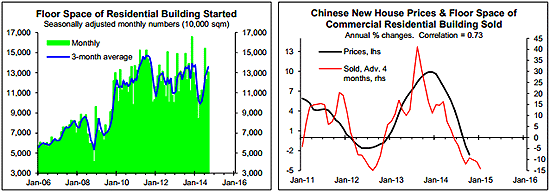
There are other mechanisms by which international developments impact on NZ, including exports, interest rates and the exchange rate, with these linkages covered in our monthly economic reports. We are currently offering a six month free trial to the monthly economic reports (contact denise@sra.co.nz if you want to take up this December only offer).
-----------------------------------------------------------------------------------
*Rodney Dickens is the managing director and chief research officer of Strategic Risk Analysis Limited.
13 Comments
"triggered the 2008 financial crisis." or was it oil at $148?
Some think it was the cost of energy into the [global] economy that drove us out of business.
regards
While I agree china etc looks bad, the World's economy has had the ability not to implode yet is and has been surprising. 6 years on and we have not had a Greater Depression MkII. Is it finally due now in 2015? or does our global economy stagger along like a zombie for some years yet? Or will all be well and we take off into the wild blue yonder?
regards
The core thesis of Rodney's paper makes sense, (and the charts and data are very interesting, thanks). The world is awash with money printed by central banks in a way that has probably never happened, and certainly not since the 1930s. Just how this will end is uncertain, and coule be problematic. That China may well have problems reining in its shadow banking sector, its property sector, and its competing provinces also makes sense. There will likely be some pain however they move away from that, although the problems look mostly internal, and will be up to them how quickly they turn off any taps.
Japan seems always less of a problem to me than the media make out. I note Moodys also downgraded Japan today, although their press release, here, rightly points out that Japan is still very sound.
Given the length of time the Japanese people and corporations have put up with/ encouraged a large government deficit suggests to me they have a better understanding of the equation where in a totally enclosed economy, a government deficit will equal a private surplus and vice versa. Leakage in or out is provided by exports vs imports, and other external payments and receipts- dividends and interest primarily. Their people and corporations like to see their own nominal wealth increase and that is guaranteed by a large fiscal deficit. It is all denominated in yen, so cannot actually be defaulted on. The deficit helps their people and coroporations buy up huge amounts of foreign assets and wealth.
Japan has a modest demographic challenge (but also an opportunity to downsize without too much pain), especially in its smaller provincial towns. I'm not convinced they have a real economic debt problem. Are they helping cause problems for everyone else including us, through currency wars and massive money printing? Probably yes, but that is not the usual problem described of them.
So imagine a new "crisis" coming up. What would happen? Even more money printing, as this is all the major central money printers have ever come up with.
This will continue until the notion of arbitrarily printable money is no longer trusted by the wider population. THEN you have a real crisis, and I think it is by now inevitable that we will end up in this very dire situation, sooner or later.
If market mechanisms had been allowed to function, the so-called "financial industry" would by now be cut back to a healthy size, houses would be affordable and we would all enjoy a better lifestyle albeit probably with less money in the kitty.
However, the greed spiral continues to spin along and most of us hope to come out on top. Good luck to us fools.
When we go into a deflationary sprial then the Q is yes indeed how to pay for things. The Govns revenue stream will collapse like it did in 2008. Consider its only now starting to break even 6 years later but the debt from the last 6 years remains. So when we go into the 2nd and 3rd recession, just where does the Govn get the money from? It either has to print, or tax or stop doing things (or a mix) it is going to be ugly IMHO.
FInancial markets should have been regulated down to size, letting the market do it would be catestrophic. No banks? well no food either.
"greed spiral continues" indeed, "fiddling while Rome burns" comes to mind.
Bear in mind however that assets are only worth what someone can pay. So that $2million for the nice house you paid for? oopsie now $200,000. Have a 80% mortgage still? oopsie you still owe us the $1.6million thanks.
At that point you default and declare bankruptcy, if you get thrown out of your house via a cort order then what?
Housing New Zealand might be a bit busy. Also the police holding down riots around the Beehive. (Think Greek Parliment ensuring they had an escape path from the Parliment buildings a few years back). The game only continues while enough ppl think they are "winning", currently about 52%.
regards
Call me I dont know what, but I still trust markets i.e. "us" a lot more than a herd of central bankers and government officials.
If a lot of banks would have been pushed out the market following 2008, others, better managed ones would have filled the void quickly. Now, the loon banks did not only cause the crisis, they are also the main beneficiaries of it. This is anti-market lunacy at its worst, it encourages new excesses and will ultimately cause the mother of all crises.
Not everyone is in debt up to the neck. Some people would have gone bankrupt, other, more cautious players would have mopped up their assets. In NZ we are lucky enough to have a social security system that looks after people in trouble (and unfortunately also people who trouble us).
Given their pathetic track record of mismanaging the economy I would at least be cautious about buying all the stuff the usual suspects are saying. A debt bubble economy is not sustainable and it is already discouraging our young and bright that a roof over the head in AKL is now a million-dollar operation.
I appreciate your point, but I still dont believe we as a society are currently doing the right or even reasonable thing.
If in 2008 these so called banks had indeed been allowed to go bankrupt the world's entire banking system incl NZ would have seized. The moral hazard of teh too big to fail scenario.
What should have happened is they should have been "absorbed" by the Govn and shutdown, I'll agree on that, its just the how.
"Not everyone is in debt" sorry but you are not taking on the leverage aspect of this, simply if only 10% or so go bankrupt (in fact I think 5~6% is mentioned) the entire banking industry is insolvent as the assets they hold is less than the debt outstanding.
I odnt believe we are doing teh right thing BTW, we cannot grow for ever on a finite planet, ergo what we are doing with expotential growth cannot continue at some point which is about now.
regards
how can the government "breakeven" remember you folks keep telling me the government makes money that's where it comes from.
if they are "breaking even" where's their revenue stream coming from? Are they "breaking even" because of the larger tax take...so they're doing well because of the damage they're doing to the economy.
Oh come on...break even in this context is where the day to day tax income matches the day to day public spending.
The tax take is recovering asthe economy is "recovering" so its not more tax per transaction, but more transactions.
regards
So imagine a new "crisis" coming up. What would happen? Even more money printing, as this is all the major central money printers have ever come up with.
That's optimistic, and it implies risk-on and lever up. However, every western country with a central bank now has "bail in" procedures firmly in place. How much leverage would you like to have in that case. I guess "bail ins" would happen overnight and would be highly deflationary.
Perhaps bail ins are just an empty threat, designed to scare the speculators. Who knows.
People need to understand that the money they store at a bank is not theirs any more, but that they have become the bank's creditor. There is a risk involved in giving money to a bank that has a record of going bust such as BNZ, for example.
Most Western countries, except NZ, also have a mandatory deposit insurance scheme that would protect must mums and dads little nest egg. The Cyprus thing ultimately did not create a lot of disruption, bail-in or not.
But in any way, Yes, doing things differently means doing things differently. Either we do it according to some kind of plan or it will have to do it after we have maxed out the current debt and more debt scheme. I dont think it can go right. Do you? Really?
Big risks for 2015 are Japan and Europe and continuing slow down in demand from China.
I can see interest rates being delayed from being lifted due to these slow downs leading to already inflated asset bubbles getting bigger (property, stocks) that will most likely deflate second half 2016. Goldman Sacchs has called the end to the Commodity supercycle for industrial metals, and milk is sloshing around, so we can expect low prices for all of next year and a pick up in 2017.


We welcome your comments below. If you are not already registered, please register to comment
Remember we welcome robust, respectful and insightful debate. We don't welcome abusive or defamatory comments and will de-register those repeatedly making such comments. Our current comment policy is here.